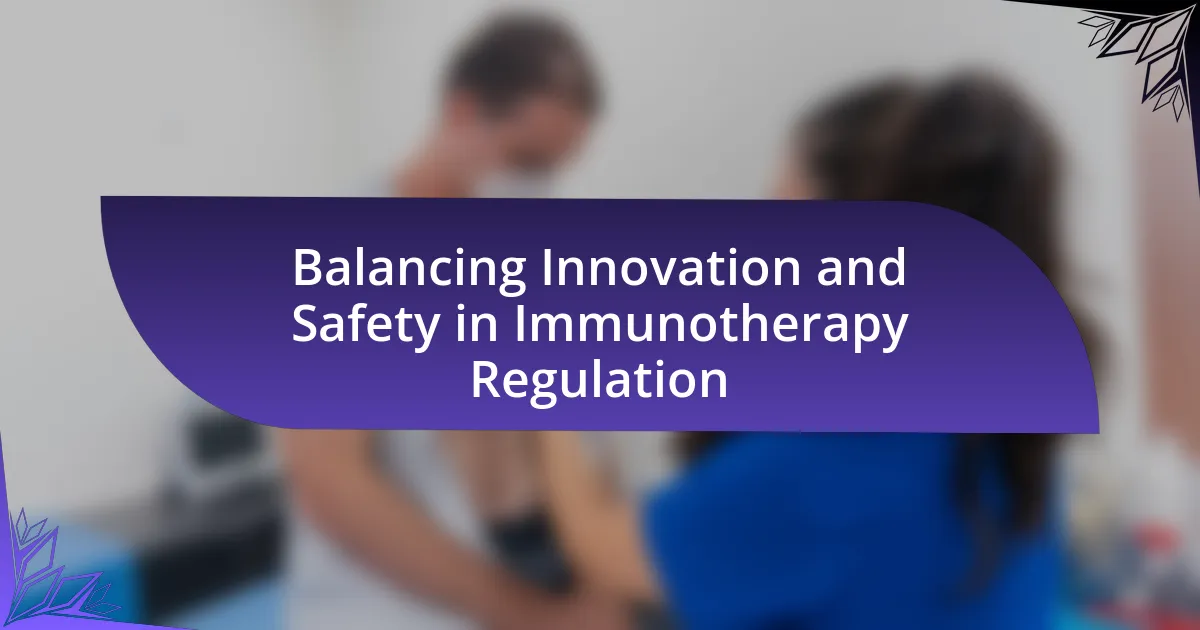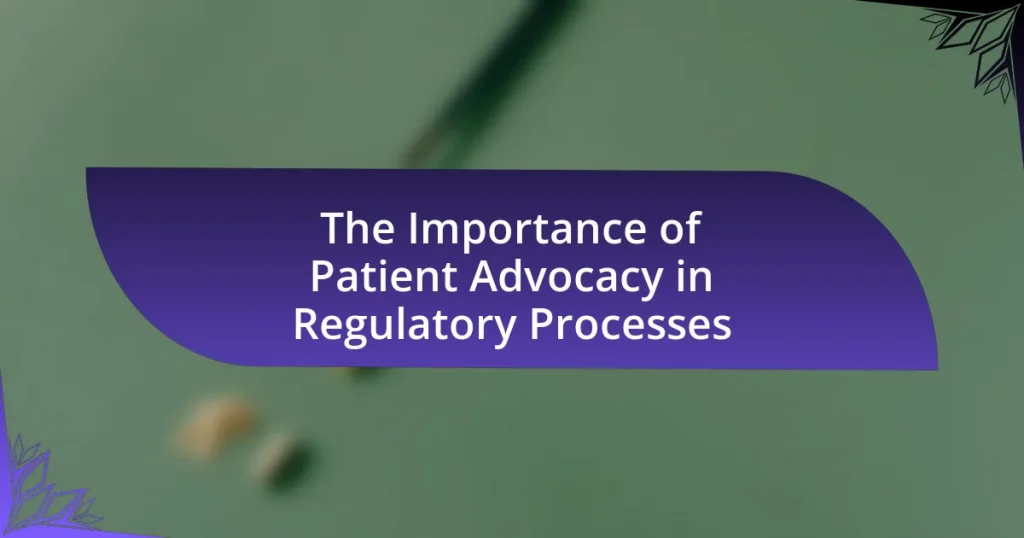Balancing innovation and safety in immunotherapy regulation is a critical focus for regulatory bodies like the FDA, which implement rigorous evaluation processes to ensure new therapies are both effective and safe for patients. The article explores the importance of this balance, highlighting the potential risks associated with immunotherapy innovations, such as severe immune-related adverse events and treatment resistance. It discusses key regulatory frameworks, the role of clinical trials, and the challenges regulators face in adapting to rapid technological advancements. Additionally, the article examines how collaboration among stakeholders, including pharmaceutical companies and patient advocacy groups, can enhance safety and streamline the regulatory process, ultimately improving patient outcomes while fostering innovation in cancer treatment.

What is Balancing Innovation and Safety in Immunotherapy Regulation?
Balancing innovation and safety in immunotherapy regulation involves ensuring that new therapies are both effective and safe for patients. Regulatory bodies, such as the FDA, implement rigorous evaluation processes to assess the efficacy and safety of immunotherapies before they reach the market. For instance, the FDA’s accelerated approval pathway allows for faster access to promising treatments while still requiring post-marketing studies to monitor long-term safety. This dual focus on innovation and safety is crucial, as it helps to mitigate risks associated with novel therapies while promoting advancements in cancer treatment.
Why is balancing innovation and safety crucial in immunotherapy?
Balancing innovation and safety in immunotherapy is crucial because it ensures effective treatment while minimizing adverse effects. Immunotherapy has shown significant promise in treating various cancers, with studies indicating that it can lead to durable responses in patients. However, the potential for severe immune-related side effects necessitates rigorous safety measures. For instance, the FDA’s approval of CAR T-cell therapies involved extensive clinical trials to assess both efficacy and safety, highlighting the importance of this balance. Ensuring that innovative therapies do not compromise patient safety is essential for maintaining public trust and advancing medical science.
What are the potential risks associated with immunotherapy innovations?
The potential risks associated with immunotherapy innovations include severe immune-related adverse events, treatment resistance, and long-term safety concerns. Immune-related adverse events can manifest as autoimmune reactions, where the immune system attacks healthy tissues, leading to conditions such as colitis, pneumonitis, or hepatitis. According to a study published in the Journal of Clinical Oncology, approximately 60% of patients receiving immune checkpoint inhibitors experience some form of immune-related adverse event. Additionally, treatment resistance can occur as tumors adapt to evade immune detection, diminishing the effectiveness of immunotherapy over time. Long-term safety concerns remain largely unaddressed, as the durability of responses and potential late-onset side effects are still being studied in ongoing clinical trials.
How can safety measures impact the pace of innovation?
Safety measures can slow the pace of innovation by imposing regulatory hurdles that require extensive testing and validation before new therapies can be introduced. For instance, in the field of immunotherapy, rigorous safety protocols are essential to ensure patient well-being, which can extend the timeline for bringing new treatments to market. According to a study published in the Journal of Clinical Oncology, the average time for clinical trials in immunotherapy can take up to 10 years, largely due to the need for comprehensive safety evaluations. This extended timeline can deter investment and slow the development of potentially groundbreaking therapies, highlighting the tension between ensuring safety and fostering rapid innovation.
What are the key regulatory frameworks governing immunotherapy?
The key regulatory frameworks governing immunotherapy include the Food and Drug Administration (FDA) regulations in the United States, the European Medicines Agency (EMA) guidelines in Europe, and the International Conference on Harmonisation (ICH) guidelines. The FDA oversees the approval and monitoring of immunotherapy products through a rigorous process that includes preclinical studies, clinical trials, and post-marketing surveillance to ensure safety and efficacy. The EMA similarly evaluates immunotherapies, focusing on the benefit-risk balance and compliance with European regulations. The ICH guidelines facilitate harmonization of regulatory requirements across different regions, promoting efficient drug development while ensuring patient safety. These frameworks collectively aim to balance innovation in immunotherapy with the necessary safety measures to protect patients.
How do these frameworks ensure patient safety?
These frameworks ensure patient safety by implementing rigorous regulatory standards and continuous monitoring of immunotherapy products. Regulatory bodies, such as the FDA, require extensive preclinical and clinical trial data to assess the safety and efficacy of new therapies before approval. For instance, the FDA’s Risk Evaluation and Mitigation Strategies (REMS) mandate ongoing safety assessments and risk communication to healthcare providers and patients. Additionally, post-marketing surveillance systems, like the FDA’s Adverse Event Reporting System (FAERS), track adverse events and ensure timely responses to safety concerns, thereby reinforcing patient safety throughout the treatment lifecycle.
What role do clinical trials play in the regulatory process?
Clinical trials are essential in the regulatory process as they provide the necessary evidence to assess the safety and efficacy of new therapies before they receive approval for public use. Regulatory agencies, such as the FDA, rely on data from clinical trials to make informed decisions about whether a treatment can be marketed. For instance, the FDA requires that clinical trials follow a rigorous protocol, including phases that evaluate the drug’s effects on human subjects, which helps ensure that any potential risks are identified and managed. This systematic approach not only safeguards patient health but also fosters innovation by allowing effective therapies to reach the market based on solid scientific evidence.
What challenges do regulators face in balancing innovation and safety?
Regulators face significant challenges in balancing innovation and safety, primarily due to the rapid pace of technological advancements in immunotherapy. The need to ensure patient safety while fostering innovation creates a tension where regulators must evaluate new therapies against established safety standards. For instance, the introduction of novel immunotherapies often involves complex mechanisms of action that can lead to unpredictable side effects, complicating the assessment process. Additionally, the urgency to bring effective treatments to market can pressure regulators to expedite approvals, potentially compromising thorough safety evaluations. This balancing act is further complicated by the evolving nature of scientific evidence, which requires regulators to adapt their frameworks continuously to accommodate new data while maintaining rigorous safety oversight.
How do emerging technologies complicate regulatory decisions?
Emerging technologies complicate regulatory decisions by introducing rapid advancements that outpace existing regulatory frameworks. For instance, the development of gene editing technologies, such as CRISPR, presents unique challenges in assessing safety and efficacy, as traditional regulatory processes may not adequately address the complexities of genetic modifications. Additionally, the integration of artificial intelligence in healthcare raises concerns about data privacy, algorithmic bias, and accountability, which existing regulations may not sufficiently cover. These factors necessitate a reevaluation of regulatory approaches to ensure they can effectively manage the risks associated with innovative therapies while fostering continued advancements in the field.
What are the implications of regulatory delays on innovation?
Regulatory delays significantly hinder innovation by prolonging the time it takes for new therapies to reach the market. These delays can lead to increased costs for developers, as they must allocate resources to navigate extended approval processes, which can stifle investment in research and development. For instance, a study published in the Journal of Health Economics found that each additional month of delay in drug approval can result in a loss of approximately $1.5 million in potential revenue per product. Furthermore, prolonged regulatory timelines can discourage startups and smaller companies from pursuing innovative solutions, as they may lack the financial resilience to withstand such delays. This ultimately results in fewer new therapies being developed, which can adversely affect patient access to potentially life-saving treatments.

How do stakeholders influence the balance between innovation and safety?
Stakeholders influence the balance between innovation and safety by advocating for regulatory frameworks that prioritize patient safety while encouraging technological advancements. Regulatory bodies, such as the FDA, rely on input from stakeholders, including pharmaceutical companies, healthcare professionals, and patient advocacy groups, to shape policies that ensure new immunotherapies are both effective and safe. For instance, the FDA’s Accelerated Approval Program allows for faster access to promising therapies while requiring post-marketing studies to monitor safety, reflecting stakeholder concerns about balancing timely innovation with rigorous safety standards.
What roles do pharmaceutical companies play in this balance?
Pharmaceutical companies play a crucial role in balancing innovation and safety in immunotherapy regulation by developing new therapies while adhering to regulatory standards. These companies invest significant resources in research and development to create innovative treatments that can improve patient outcomes. For instance, in 2020, the global pharmaceutical industry spent approximately $83 billion on R&D, highlighting their commitment to innovation.
Simultaneously, pharmaceutical companies must comply with stringent regulations set by agencies like the FDA and EMA to ensure the safety and efficacy of their products. This dual responsibility requires them to conduct rigorous clinical trials, which are essential for demonstrating the safety of new immunotherapies before they reach the market. In 2021, the FDA approved 50 novel drugs, many of which were immunotherapies, reflecting the successful navigation of this balance between innovation and safety.
Thus, pharmaceutical companies are integral to advancing immunotherapy while ensuring that patient safety remains a top priority through compliance with regulatory frameworks.
How do companies advocate for faster regulatory processes?
Companies advocate for faster regulatory processes by engaging in direct dialogue with regulatory agencies, participating in industry coalitions, and leveraging data to demonstrate the safety and efficacy of their products. For instance, pharmaceutical companies often collaborate with the FDA to streamline approval pathways, as seen in the Breakthrough Therapy designation, which expedites the development and review of drugs that treat serious conditions. Additionally, companies may conduct public awareness campaigns to highlight the benefits of timely access to innovative therapies, thereby influencing public policy and regulatory frameworks. This approach is supported by evidence showing that faster regulatory processes can lead to improved patient outcomes and increased market competitiveness.
What responsibilities do companies have towards patient safety?
Companies have a fundamental responsibility to ensure patient safety by adhering to rigorous regulatory standards and conducting thorough clinical trials. This includes implementing quality control measures, monitoring adverse effects, and ensuring transparency in reporting safety data. For instance, the U.S. Food and Drug Administration (FDA) mandates that companies submit comprehensive safety information during the drug approval process, which is crucial for assessing the risk-benefit profile of immunotherapies. Additionally, companies must engage in post-marketing surveillance to identify any long-term safety issues that may arise after a product is on the market. This commitment to patient safety is essential not only for regulatory compliance but also for maintaining public trust and ensuring the efficacy of innovative treatments.
How do patient advocacy groups contribute to regulatory discussions?
Patient advocacy groups contribute to regulatory discussions by representing the interests and experiences of patients, thereby influencing policy decisions. These groups provide critical insights into patient needs, treatment preferences, and the real-world impact of therapies, which regulators may not fully understand. For instance, the FDA has recognized the importance of patient input in its regulatory processes, as evidenced by initiatives like the Patient-Focused Drug Development program, which aims to incorporate patient perspectives into drug evaluation. This collaboration helps ensure that regulatory frameworks balance innovation with safety, ultimately leading to more effective and patient-centered healthcare solutions.
What perspectives do these groups bring to the table?
Various stakeholders, including regulatory agencies, pharmaceutical companies, healthcare professionals, and patient advocacy groups, bring distinct perspectives to the discussion on balancing innovation and safety in immunotherapy regulation. Regulatory agencies prioritize patient safety and efficacy, ensuring that new therapies meet rigorous standards before approval. Pharmaceutical companies focus on innovation and market competitiveness, advocating for streamlined processes that facilitate quicker access to new treatments. Healthcare professionals emphasize the importance of clinical evidence and real-world effectiveness, seeking to integrate new therapies into practice while ensuring patient safety. Patient advocacy groups highlight the need for access to cutting-edge therapies, often pushing for regulations that consider patient experiences and outcomes. These diverse perspectives contribute to a comprehensive dialogue aimed at optimizing immunotherapy regulation while safeguarding public health.
How can patient feedback shape regulatory policies?
Patient feedback can shape regulatory policies by providing insights into real-world experiences and outcomes, which can inform the development and adjustment of regulations. Regulatory bodies, such as the FDA, utilize patient-reported outcomes to understand the effectiveness and safety of treatments, ensuring that policies reflect the needs and concerns of patients. For instance, the FDA’s Patient-Focused Drug Development initiative emphasizes gathering patient input to guide drug approval processes, demonstrating that patient feedback directly influences regulatory frameworks. This approach not only enhances the relevance of regulations but also fosters a more patient-centered healthcare system.

What best practices can enhance the balance between innovation and safety in immunotherapy regulation?
Implementing adaptive regulatory frameworks can enhance the balance between innovation and safety in immunotherapy regulation. These frameworks allow for real-time data collection and analysis during clinical trials, enabling regulators to make informed decisions based on emerging safety and efficacy data. For instance, the FDA’s Breakthrough Therapy Designation expedites the development and review of therapies that treat serious conditions, while still requiring rigorous safety assessments. Additionally, fostering collaboration between regulatory agencies, researchers, and industry stakeholders can facilitate knowledge sharing and streamline the approval process without compromising safety standards. This collaborative approach has been shown to improve the efficiency of bringing innovative therapies to market while maintaining patient safety, as evidenced by the successful integration of patient feedback in trial designs, which has led to more relevant and safer treatment options.
How can collaboration between stakeholders improve outcomes?
Collaboration between stakeholders can significantly improve outcomes by fostering shared knowledge and resources, leading to more effective decision-making in immunotherapy regulation. When stakeholders such as researchers, regulatory bodies, healthcare providers, and patients work together, they can identify potential risks and benefits more comprehensively, ensuring that innovative therapies are both safe and effective. For instance, the FDA’s collaboration with pharmaceutical companies and academic institutions has resulted in streamlined approval processes for immunotherapies, enhancing patient access while maintaining safety standards. This collaborative approach not only accelerates the development of new treatments but also ensures that diverse perspectives are considered, ultimately leading to better health outcomes for patients.
What models of collaboration have proven effective in the past?
Effective models of collaboration in the context of immunotherapy regulation include public-private partnerships, multi-stakeholder collaborations, and cross-disciplinary research initiatives. Public-private partnerships, such as the Accelerating Medicines Partnership, have successfully brought together government agencies, non-profit organizations, and pharmaceutical companies to streamline drug development processes. Multi-stakeholder collaborations, exemplified by the Coalition for Epidemic Preparedness Innovations, have effectively mobilized resources and expertise to address urgent health challenges. Cross-disciplinary research initiatives, like the Cancer Moonshot, have fostered collaboration among scientists, clinicians, and regulatory bodies to enhance innovation while ensuring safety. These models have demonstrated their effectiveness through accelerated timelines for drug approvals and improved patient outcomes.
How can shared data enhance safety and innovation efforts?
Shared data enhances safety and innovation efforts by facilitating real-time monitoring and analysis of treatment outcomes, which leads to improved decision-making in immunotherapy regulation. For instance, when clinical trial data is shared among researchers and regulatory bodies, it allows for a comprehensive understanding of adverse effects and efficacy across diverse populations. This collective insight can accelerate the identification of safety concerns and the development of innovative treatment protocols. A study published in the Journal of Clinical Oncology found that shared data from multiple trials significantly reduced the time needed to identify safety signals, thereby enhancing patient protection while fostering innovation in treatment approaches.
What strategies can regulators adopt to streamline the process?
Regulators can adopt several strategies to streamline the process of immunotherapy regulation, including implementing adaptive licensing, enhancing collaboration with stakeholders, and utilizing real-world evidence. Adaptive licensing allows for a phased approval process, enabling quicker access to therapies while ensuring ongoing safety monitoring. Enhanced collaboration with industry, healthcare providers, and patient advocacy groups fosters a more efficient dialogue, leading to clearer guidelines and faster feedback loops. Utilizing real-world evidence, such as data from post-marketing studies, can inform regulatory decisions and reduce the need for extensive pre-approval trials, thereby accelerating the overall timeline for bringing innovative therapies to market. These strategies have been shown to improve regulatory efficiency while maintaining safety standards, as evidenced by successful case studies in various therapeutic areas.
How can adaptive regulatory pathways facilitate innovation?
Adaptive regulatory pathways facilitate innovation by allowing for a more flexible and iterative approach to the development and approval of new therapies. This flexibility enables companies to gather real-world evidence and make adjustments based on ongoing data, which can accelerate the introduction of innovative treatments to the market. For instance, the FDA’s Breakthrough Therapy designation exemplifies this approach, as it expedites the development and review processes for therapies that treat serious conditions and fill an unmet medical need, thereby fostering innovation while maintaining safety standards.
What role does continuous monitoring play in ensuring safety?
Continuous monitoring plays a critical role in ensuring safety by providing real-time data that allows for the early detection of adverse effects and potential risks associated with immunotherapy treatments. This proactive approach enables healthcare providers and regulatory bodies to respond swiftly to any safety concerns, thereby minimizing harm to patients. For instance, studies have shown that continuous monitoring can lead to a 30% reduction in adverse events by identifying issues before they escalate. By integrating continuous monitoring into immunotherapy regulation, stakeholders can maintain a balance between innovation and patient safety, ensuring that new therapies are both effective and safe for public use.
What are the key takeaways for balancing innovation and safety in immunotherapy regulation?
Key takeaways for balancing innovation and safety in immunotherapy regulation include establishing adaptive regulatory frameworks that allow for real-time data collection and analysis, ensuring robust preclinical and clinical trial designs to assess safety and efficacy, and fostering collaboration between regulatory agencies, researchers, and industry stakeholders. Adaptive frameworks, such as the FDA’s Breakthrough Therapy designation, enable faster patient access to promising therapies while maintaining safety standards. Comprehensive trial designs, including phase I/II trials that incorporate biomarker-driven approaches, help identify potential risks early. Collaboration enhances transparency and accelerates the development of safe, effective immunotherapies, as evidenced by initiatives like the Accelerating Medicines Partnership, which brings together public and private sectors to streamline research and regulatory processes.



